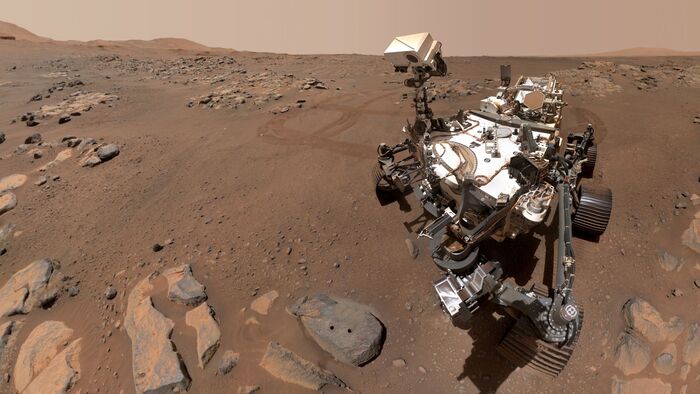This is the new robot that will explore Mars 3:41
(CNN) -
Hundreds of people have dedicated almost 10 years of work to developing NASA's most advanced robotic rover, the Perseverance rover, and the time is here.
The rover is scheduled to land on Mars at 3:55 p.m. Miami time Thursday.
Perhaps one of the most difficult jobs was preparing the mission during its final stages before launching in July during a pandemic.
Like the name of the mission, his team persevered to make this happen and launch the rover rather than accept a delay that would be costly in both scientific and economic loss.
The rover pays tribute to healthcare workers around the world.
The 7 by 12 cm aluminum plate, installed on the left side of the rover's chassis, shows the Earth held up by the ancient symbol of the serpent entwined around a rod to represent the global medical community.
One line represents the path of the rover from Florida to Mars, according to NASA.
This commemorative plaque is installed on the Perseverance rover.
"We wanted to show our appreciation for those who have put their personal well-being on the line for the good of others," Matt Wallace, Perseverance deputy director of projects at NASA's Jet Propulsion Laboratory in Pasadena, California, said in a statement.
"We are hopeful that when future generations travel to Mars and meet our rover, they will be reminded that there were such people on Earth in 2020."
advertising
Perseverance also bears the names of nearly 11 million people engraved on three silicon chips.
He is a robotic scientist who explores Mars on behalf of humanity, and will be able to share what he sees and hears through 23 cameras, including video, and two microphones.
Along the journey is Ingenuity, the first helicopter to fly over another planet.
"I am in awe that we are one day away from landing on this ancient lake bed in search of potential ancient life," said Thomas Zurbuchen, associate administrator for NASA's Science Mission Directorate.
"It is the culmination of decades of work by NASA and the international community."
LEE
: Perseverance is approaching Mars: songs to celebrate the arrival of the rover to the red planet
The Perseverance Journey
Talks began about the Perseverance rover, then known as the Mars 2020 mission, shortly after the Curiosity rover landed in 2012, said Steve Jurczyk, acting NASA administrator.
Missions start with science.
Mars 2020 was designed to focus on investigating potentially habitable places on Mars that could have supported ancient life, as well as exploring the planet's geological and climatic history, he said.
It would be modeled after Curiosity's design, but weigh a little more, move a little faster, and stand a little higher.
And it would need a new set of scientific instruments to investigate whether life was ever possible on Mars and, if so, to look for evidence of that ancient life.
Perseverance - "Persy" as her team affectionately calls her - would also go to the most intriguing, but most treacherous landing site, yet in Jezero Crater.
Full of dangers like cliffs and rocks, it was once the site of an ancient lake and river delta 3.9 billion years ago.
Previous NASA rovers like Spirit, Opportunity and Curiosity have "followed the water" to learn more about what Mars was like in the past.
The Viking mission was intended to search for life on the red planet, but NASA scientists have since learned more about Mars, as well as how life forms and exists on Earth, helping them formulate hypotheses about what it could do on other planets.
"We know that the experiments we designed were probably not the right way to do that exercise," said Lori Glaze, director of NASA's Division of Planetary Sciences.
"Perseverance is the first real astrobiology mission and one of its main purposes is to look for those signs of past life on Mars."
LEE
: He arrived from Colombia without knowing English and today he takes NASA's Perseverance to Mars: the story of Diana Trujillo
Landing on mars
Perseverance will land itself on Mars on Thursday.
He has received his orders and is ready to go, his mission team confirmed Wednesday.
Due to the time lag between Earth and Mars, Perseverance will be on his own during the "7 minute terror" of landing.
It plunges into the atmosphere at 19,000 kilometers per hour and has to slow down, using parachutes and retro rockets, to 0 km per hour seven minutes later when it reaches the surface.
His team will be watching the data it transmits through the Mars Reconnaissance Orbiter to know if it landed safely or not.
So the real journey begins when the rover explores Jezero Crater for the next two years.
While the Perseverance rover is highly autonomous, you still need to talk to your teams on Earth before driving on Mars, firing lasers at rocks, or collecting samples.
Your teams, with members scattered around the world, will transition to "Mars time," beginning their days around 2 pm local time on Mars.
For many, especially those at NASA's Jet Propulsion Laboratory, this means getting up later in the day and working into the night.
"Mars days are 40 minutes longer than Earth days, so you always change 40 minutes every day and that causes jet lag," said Jennifer Trosper, Perseverance deputy project manager.
"But we do this because we want to be very efficient with the mission."
Basically Perseverance crews need to be awake when the rover is awake.
Trosper has worked all five rover missions, and finally she couldn't take it anymore and bought a sleep mask this year so she's ready to be on Mars for a while.
"We really want to land tomorrow," Jurczyk said.
«The team has done an incredible job.
They always do, and in particular, being able to have launched in July, and now land in these really challenging times.
It is going to be an incredible mission, between the scientific knowledge that we are going to gain and the technology that it will demonstrate.
And then the caching samples for the Mars Sample Return mission, which we plan to launch in 2026 and return the samples in the early 2030s. This is going to be a really amazing mission.
The agency has been sending missions to explore Mars since 1965, sharing images and acquired knowledge about our fascinating neighbor.
Mars has been one of the most accessible places in our solar system to send missions.
But it also has a mysterious history and may once have looked a lot like Earth, which means it's a great place to search for ancient life.
LOOK
: Jezero, the crater of Mars that the NASA Perseverance rover will explore
"Mars is the most Earth-like planet in our solar system," Jurczyk said.
"That is really intriguing because by studying the geological and climatic history of the planet and how it evolved, we can also report how the Earth has evolved and how it will evolve in the future."
Capable robots exploring Mars now lay the groundwork for landing human missions on the red planet in the future, Jurczyk said.
rover Perseverance














